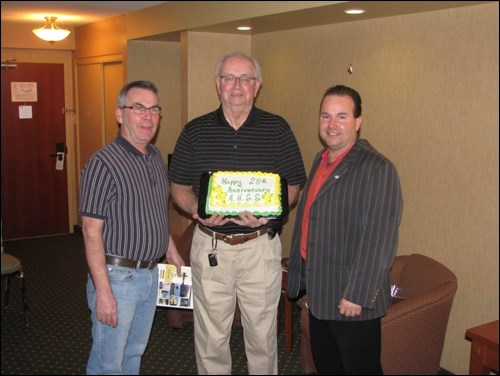The Battleford Opera House project was on the agenda for the annual meeting Saturday of the Architectural Heritage Society of Saskatchewan (AHSS).
Meeting in North Battleford, directors of provincial group celebrating its 25th anniversary this year heard a presentation from Battleford mayor Chris Odishaw regarding the restoration of the Opera House, a Municipal Heritage Property, and Battleford's plan to make it the first place visitors to the town will want to see.
To date, the project has seen the Town Hall's roof restored to its original arched shape from a more recent sloped roof renovation, along with an upgrade in energy efficiency. It was this phase of the project Municipal Heritage Property that earned an AHSS-initiated award for the Town of Battleford and Rajani Blaser Mannix Architecture.
The mayoral tenure of Odishaw, who has announced he will not be running for re-election in 2012, has established a reputation as one based on concerted efforts to attract new business to Battleford. But it will also be known as one in which the architectural history of Battleford became integral to its growth.
At Saturday's meeting, Odishaw fleshed out the story of the Opera House project for the SHSS directors, starting with how the once-central part of Battleford's community life fell into disuse after a fire in 1965.
The Opera House, the upper floor of the classically-inspired town hall building constructed in 1912, had once been the cultural centre for the community a place to hold such events as school plays, high school graduations, live theatre, musical talent nights, Christmas concerts, dances and firemen's banquets. But, by the time of the fire, schools had begun adding their own gymnasiums and community halls had been built by various groups throughout the town, putting the Opera House in a position of "not needed" when it came time to decide whether or not to repair the damage.
The council of the day, said Odishaw, saw no need to spend the $10,000 it would have then cost to bring the Opera House back up to safety codes, and it was closed up.
When he first walked into Town Hall as the new mayor six year ago, having successfully campaigned on the premise of running the town "like a business," the Opera House was nothing but a fascinating legend to Odishaw. He wasn't even aware it was actually located in the town hall building.
When he was invited to take a tour of the Opera House, he found himself in a large open space with a soaring seven metre-high ceiling, prominent stage, and round-arch windows that made the hair stand up on his arms. And when the fire escape door was opened and the he saw the vista of the river valley below, his vision as mayor began changing. It started moving toward "balance" and "legacy," and how the restoration of the Opera House could bring those things into his vision.
Still, the businessman in him knew it was necessary to "pick up on the business case," as well if the Opera House was once again going to become an integral part of the community.
While councils of the past have considered the possibility of refurbishing the Opera House, the cost to taxpayers to bring the facility up to fire and safety codes seemed greater than the payoff. A study done in 1979 indicated that in order to meet safety codes, as well as bring the Opera House up to a standard that could compete with other facilities, fully a third of the space would have been lost to kitchen, washrooms and a new staircase.
That, said Odishaw, would have made it into something other than what the space was intended to be. Some other way of making it happen would have to be found.
So, he took his first three months of salary as mayor, and retained design engineer Jeff Mannix of Rajani Blaser Mannix Architecture, to put together a plan that revolved around an auxiliary building providing the space for entry, an elevator, kitchen and washrooms, plus an observation deck from which could be seen 27 historic sites of the area.
The current council got behind this new vision and the project was launched. Direct taxation of the community was replaced by fundraising initiatives, including the sale of a special edition of art prints, and applying for whatever grants might be available to that type of project.
The first phase of the project is complete, and now community input is 小蓝视频 gathered in order to make the most of the Opera House's possibilities and ensure its sustainability.
Odishaw said, "We are building a complete business plan around it."
There has been a great deal of support and interest in the project, said Odishaw. Even visitors from Australia have gone home with pieces of the art from the fundraising campaign, and the great-grandson of the original builder plans to hold a family reunion there once it is opened, he said.
AHSS directors were also interested in Odishaw's initiative to have new and old construction in Battleford relate to its architectural heritage. He told the story of transforming an historic, but ugly, building on the town's main street with an historically appropriate fa莽ade, and how other businesses have followed suit.
AHSS president, Al Gill, commended Odishaw on the Opera House project and thanked him for sharing the methods that have been undertaken to make the project possible. These are the kinds of projects the AHSS aims to support, and they continue to look for ways they can provide that support.
The directors agreed to provide a letter of support for use in the next application that will be made to the federal government for funding. And they happily agreed to accept the donation of a plasma television from Odishaw's business, Battleford Furniture, for use as a prize in video promotion 小蓝视频 put together for posting on the Internet's YouTube and Facebook.




